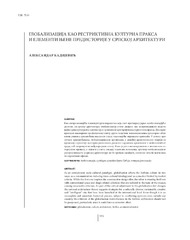Приказ основних података о документу
Globalizacija kao restriktivna kulturna praksa i elementi njene predistorije u srpskoj arhitekturi
Globalisation as restrictive cultural practice and elements of its prehistory in Serbian architecture
| dc.creator | Kadijević, Aleksandar | |
| dc.date.accessioned | 2021-10-12T12:59:09Z | |
| dc.date.available | 2021-10-12T12:59:09Z | |
| dc.date.issued | 2019 | |
| dc.identifier.issn | 1450-605X | |
| dc.identifier.uri | http://reff.f.bg.ac.rs/handle/123456789/2802 | |
| dc.description.abstract | Kao sveprožimajuća sociokulturna paradigma koja svet pretvara u jedno mesto smanjujući razlike, na srpsku arhitekturu globalizacija utiče dvojako: kao komunikacijski podsticajna transkulturalna ideologija i tržišnim kriterijumima ograničena praksa. Dok prvi princip inspiriše projektantsku elitu, drugi podstiče konvencionalna prostorno-oblikovna rešenja prilagođena masovnom ukusu, izazivajući opravdane primedbe. U sklopu kritičkih prilagođavanja globalizacijskim promenama, u domaćoj arhitektonskoj teoriji se predlažu strategije kulturno raznolikog, razvojno održivog, kreativnog i inteligentnog grada, već pokrenute na međunarodnom nivou. Iako je reč o nezaokruženom i neizvesnom istorijskom procesu, o kojem i u svetu vladaju podeljena mišljenja, kritiku globalizacijske restriktivnosti u srpskoj arhitekturi ne bi trebalo odgađati, pogotovo što bi mogla imati korektivan efekat. | sr |
| dc.description.abstract | As an omnipresent socio-cultural paradigm, globalisation affects the Serbian culture in two ways: as a communication-inducing trans-cultural ideology and as a practice limited by market criteria. While the first one inspires the construction design elite, the other is wearing itself out with conventional space and shape-related solutions that are tailored to the taste of the masses, causing reasonable criticism. As part of the critical adjustment to the globalisation-led changes, the national architecture theory suggests strategies for a culturally diverse, sustainable, creative and "intelligent" city that have been launched at the international level. Even though it is an incomplete and uncertain historical process, subject to conflicting opinions even outside our country, the criticism of the globalisation restrictiveness in the Serbian architecture should not be postponed, particularly since it could have a corrective effect. | en |
| dc.publisher | Zavod za zaštitu spomenika kulture grada Beograda, Beograd | |
| dc.rights | openAccess | |
| dc.rights.uri | https://creativecommons.org/licenses/by/4.0/ | |
| dc.source | Nasleđe | |
| dc.subject | Srbija | sr |
| dc.subject | kultura | sr |
| dc.subject | komercijalizacija | sr |
| dc.subject | globalizacija | sr |
| dc.subject | arhitektura | sr |
| dc.subject | Serbia | en |
| dc.subject | globalization | en |
| dc.subject | culture | en |
| dc.subject | commercialization | en |
| dc.subject | architecture | en |
| dc.title | Globalizacija kao restriktivna kulturna praksa i elementi njene predistorije u srpskoj arhitekturi | sr |
| dc.title | Globalisation as restrictive cultural practice and elements of its prehistory in Serbian architecture | en |
| dc.type | review | |
| dc.rights.license | BY | |
| dc.citation.epage | 133 | |
| dc.citation.issue | 20 | |
| dc.citation.other | (20): 115-133 | |
| dc.citation.rank | M52 | |
| dc.citation.spage | 115 | |
| dc.identifier.doi | 10.5937/nasledje1920115K | |
| dc.identifier.fulltext | http://reff.f.bg.ac.rs/bitstream/id/1482/2799.pdf | |
| dc.type.version | publishedVersion |

